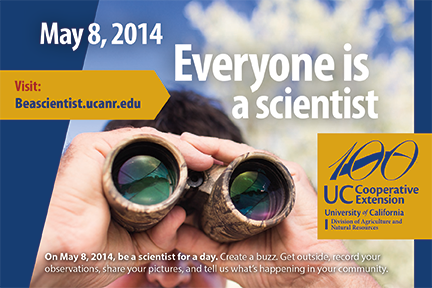
Posts Tagged: CCD
Colony collapse disorder: still with us?
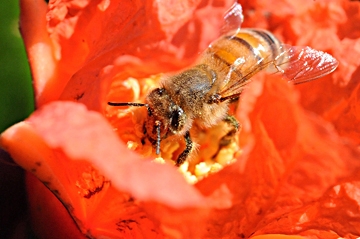
"Does colony collapse disorder (CCD) still exist?"
Eric Mussen, UC Cooperative Extension specialist in the Department of Entomology and Nematology at UC Davis says "yes."
But the winter losses are being attributed to many other causes. "Less than 10 percent of the losses are now attributed to CCD," Mussen points out.
CCD surfaced in the fall of 2006 when beekeepers starting seeing their colonies decimated. They'd open the hive, only to find the queen, the brood and the food stores. The adult workers? Gone.
"CCD still exists and it appears as though in cases where multiple other stresses combine to severely weaken the bees, then viruses can overwhelm the immune system and the bees fly away and die," Mussen says. "We do not know what causes apparently-sick bees to fly from the hive, and we still have a difficult time describing how all the bees could become affected so swiftly."
"As colony losses mounted, the beekeepers had to spend even more time monitoring the conditions of their colonies. They noted things that might be done to prevent some problems that seemed to be starting. So, we are better at preventing the losses, but the percentage for about 25 percent of our beekeepers is still way too high."
Mussen says that "the other 75 percent of the beekeepers are doing relatively well (5-15 percent losses), so we have leveled off in national colony numbers. If the 25 percent can better determine what is going wrong, we should see improved data in the future."
Scientists attribute CCD to a combination of causes, including pests, pesticides, viruses, diseases, malnutrition, and stress. The No. 1 problem in the hives, they agree, is the varroa mite. Mussen writes about those topics - and others in his newsletter, from the UC Apiaries and "Bee Briefs." Both are available free on his website.
Mussen, who is retiring in June after 38 years of service, was recently named the recipient of the 2013-14 Distinguished Service Award, sponsored by the UC Division of Agriculture and Natural Resources.
Mussen devotes his research and extension activities toward the improvement of honey bee health and honey bee colony management practices. Mussen, who joined the UC Davis department in 1976, is known throughout the state, nation and world as “the honey bee guru” and “the pulse of the bee industry" and as "the go-to person" when consumers, scientists, researchers, students and the news media have questions about honey bees.
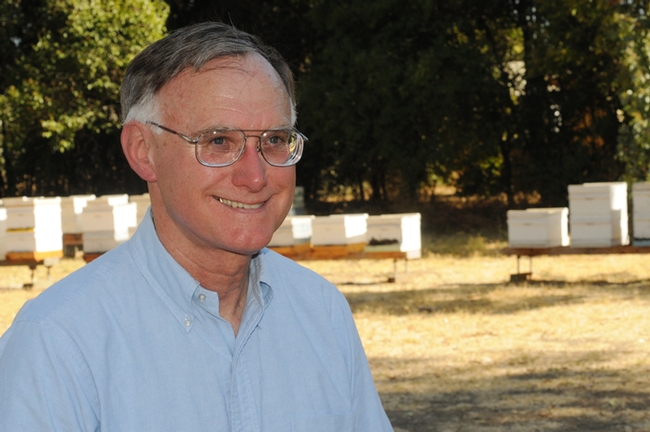
Extension apiculturist Eric Mussen in front of the apiary at the Harry H. Laidlaw Jr. Honey Bee Research Facility at UC Davis. (Photo by Kathy Keatley Garvey)
Pollinators in trouble
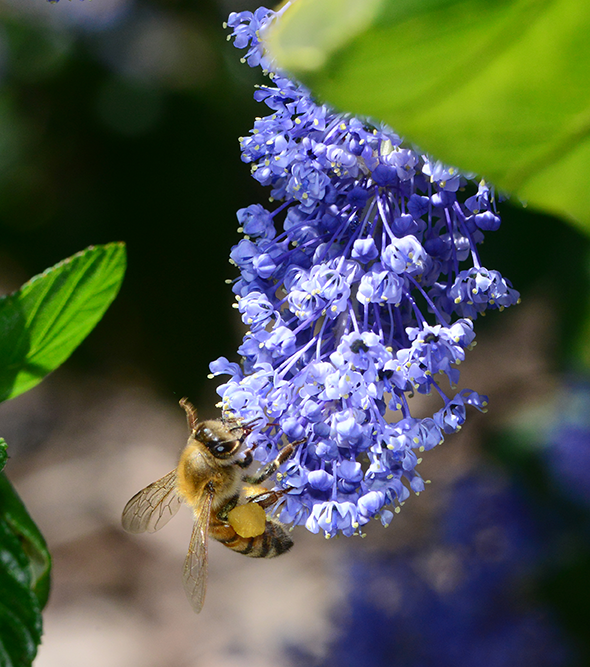
“I'll be holding a precious resource in my hands, one that is essential to life on earth,” says Allen-Diaz. “I'll be placing my hands in Norm's hands to raise awareness about the value of honeybees.”
While raising money for education is certainly a worthy goal, as Allen-Diaz says, the event also draws attention to the plight of our most important agricultural pollinator. In 2006, a number of beekeepers in the Western U.S. noticed their hives had lost 30 to 70 percent of their worker bees. The phenomenon, now known as colony collapse disorder (CCD), is still not fully understood, though a number of factors are believed to be involved. They include habitat loss or degradation and fragmentation, poor nutrition, certain bee management and agricultural practices, natural and chemical toxins, diseases, and parasites. Any one of these factors can affect the insects' ability to combat any of the others. Isolating a single cause, if there is one, has proved elusive.
Many of the fruits and vegetables on the tables of the world are pollinated by insects, particularly bees, and if they were to disappear, our sources of plant food would be restricted to grains and not too much else. It's no wonder CCD is such a concern (for example, see the United Nations Environmental Program 2010 report on Global Bee Colony Disorder and USDA, Honey Bees and Colony Collapse Disorder.
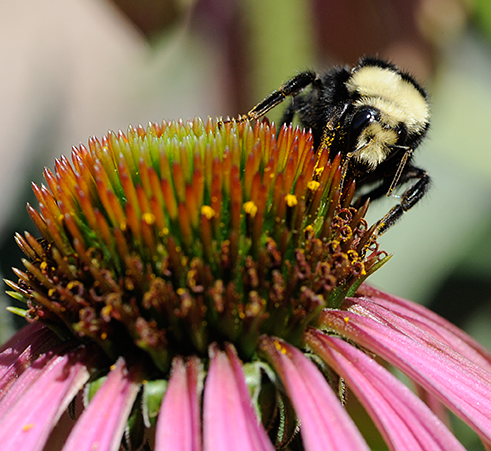
As human population grows and becomes more urban, and as habitats get more fragmented, it is no longer adequate to focus conservation efforts merely in non-urban, non-working landscapes.
“We need to figure out how to accommodate as many native species as possible in these kinds of places,” says Patrick Huber of the City of Davis Open Space and Habitat Commission, which has adopted pollinator habitat enhancement as a working goal. The Commission is working to compile a GIS dataset of known big patches of habitat in Davis, in order map pollinator resources around town.
Huber is a geographer in the Landscape Analysis and Systems Research lab at UC Davis, where he focuses on spatial scale in conservation planning. He is working on a tool to help match gardeners with plants that will grow well in their regions, that are locally available, and that provide a network of resources for pollinators throughout the urban landscape and on into the agricultural landscape. For the moment this project is being piloted in Davis, but the hope is to expand it to other communities, tying in resources such as CalFlora.
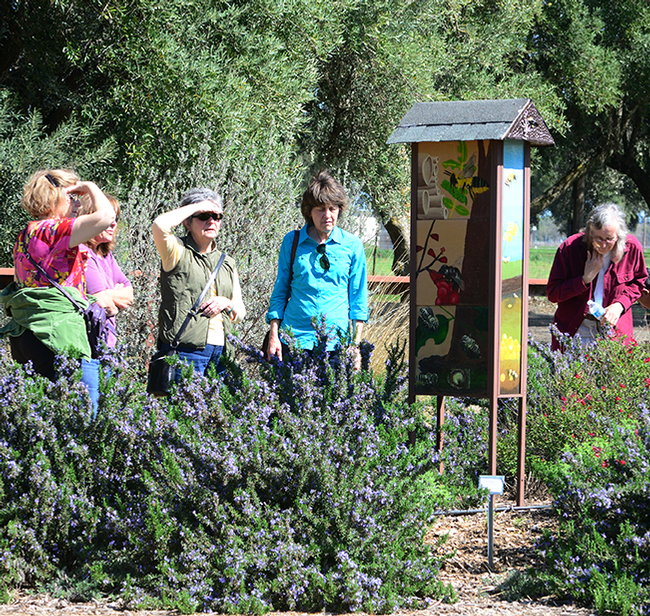
- Planning for succession blooming (in the Central Valley, that means late winter through fall)
- Putting plants in clumps at least 4 feet long if possible (honeybees, especially, like to specialize)
- Putting in plants that provide both nectar and pollen (nectar is fuel for adult bees, pollen is protein for the young)
- Using native plants where possible; they're drought tolerant and have what our native bees need
- Avoiding most-toxic pesticides and herbicides
- Providing a clean source of water (a slow-dripping tap on a sloped surface is ideal; bees like to drink from very shallow sources)
- Providing cavity nest holes in wood for carpenter and other bees
- Leaving some areas of gardens unmulched for ground-nesting bees
There are ways the agricultural landscape can be made more hospitable, too. Neal Williams, professor of entomology at UC Davis, has been working on a project to install 600- to 800-meter plots of flowering plants alongside large fields as resources for pollinators. This has moved out of the trial phase into test plots in coastal and foothill areas as well as in the Central Valley.
Meanwhile, we can all help count our pollinators on May 8, the Day of Science and Service to celebrate 100 years of Cooperative Extension in California. We'll be conducting our own pollinator count here outside the ANR building in Davis: join us, or let us know about yours!
Many thanks to Kathy Keatley Garvey for use of her photos.
Zeroing in on Honey Bee Decline
Honey bee guru Eric Mussen talks a lot about the declining honey bee population. After all, he's served as the Extension apiculturist with the UC Davis Department of Entomology since 1976. Over the last several weeks, however, he's been fielding scores of phone calls from the news media and...
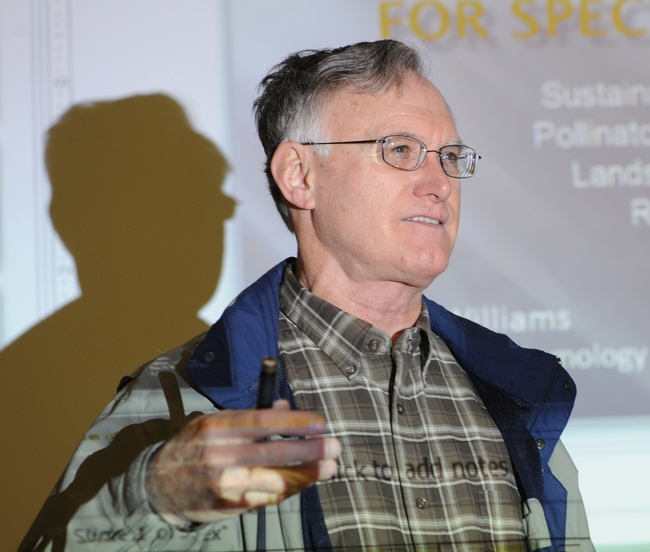
Extension apiculturist Eric Mussen answers questions from a Woodland crowd. (Photo by Kathy Keatley Garvey)
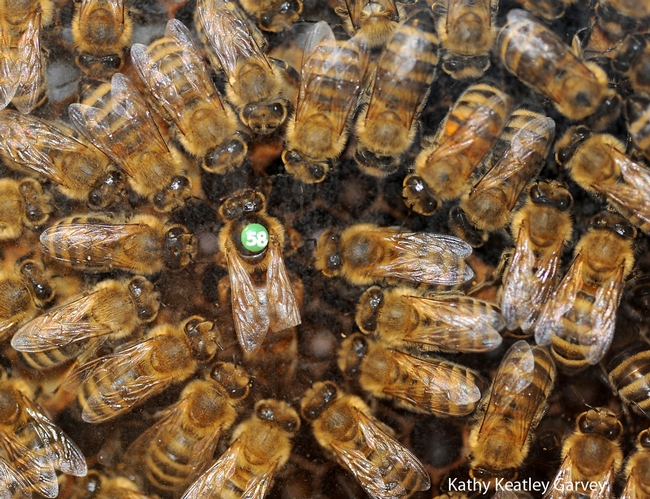
Queen bee and her retinue. (Photo by Kathy Keatley Garvey)
Marin team designed the Honey Bee Haven
When Jessica Brainard picked up a pint of Häagen-Dazs ice cream at a Sausalito 7-Eleven in 2008, she added a link to a chain of events that culminate tomorrow with the official grand opening of the Häagen-Dazs Honey Bee Haven at UC Davis.
Brainard was featured in a Marin Independent Journal article that detailed how she and three other local landscape designers followed a link on that fateful ice cream carton, leading to their having a substantial role in the creation of the half-acre garden that will raise awareness about the plight of the honey bee.
Interpretative planner Brainard, landscape architect Donald Sibbett, landscape architect Ann F. Baker and exhibit designer Chika Kurotaki won the garden design competition and a year's supply of Häagen-Dazs ice cream. Their winning design plan (pdf) can be viewed online.
The team designed the garden with:
Honeycomb Hideout, a space with large-blossomed plants and an over-sized honey bee sculpture that gives visitors a sense of a garden from a bees-eye point of view Waggle Dance Way, a path on which visitors can meander through a natural landscape Pollinator Patch, full of berries and fruit trees Save-the-Bee Sanctuary, which tells the story of how bees pollinate much of America's food My Backyard Garden, with perennials and a lawn substitute, which illustrate how almost anyone can make a garden bee-friendly Nectar Nook, shows how to create a natural-looking oasis for bees with native and drought-tolerant Mediterranean plants Langstroth Lane, a walkway with a pair of trellises that gives visitors the sense of entering and exiting frames of a bee box "It was really important to give visitors an emotional connection to the plight of honey bees," Brainard told reporter Debbie Arrington. "We wanted them to understand how important they are to our food production and to our life. This garden celebrates that and provides practical examples to promote bee-friendly backyards." The garden, planted last year, already houses a vast diversity of bees, including bumblebees, carpenter bees, leaf cutters, borer bees, mason bees and sweat bees. The grand opening event, free and open to the public, is from 10 a.m. to 2 p.m., Saturday, Sept. 11, at the Harry H. Laidlaw Jr. Honey Bee Research Facility, Bee Biology Road, University of California, Davis. More information is available in a news release by Department of Entomology writer Kathy Keatley Garvey.

The honey bee haven at UC Davis.
Honey bee haven home to 6 million bees
The new Häagen-Dazs Honey Bee Haven at UC Davis will be dedicated Sept. 11, but it is already buzzing with activity, according to a feature that appeared in Saturday's Sacramento Bee.The half-acre refuge is already home to more than 6 million bees representing 55 species, including bumblebees, carpenter bees, leaf cutters, borer bees, mason bees and sweat bees, the article said.
The garden was transformed from a neglected patch of land - described as a giant concrete brick by the program manager - into a bee sanctuary of mostly drought-tolerant, easy-care perennials and shrubs that bloom year round. The compost for the garden came from scraps from campus cafeterias. A giant honey bee sculpture sits on a pedestal decorated with mosaics by schoolchildren, UC Davis students and others.
Interest in bees has grown in recent years due to the insects' well-publicized struggle with colony collapse disorder.
"A lot of people are asking, 'What can I do to help?'" UC Davis entomologist Eric Mussen told Bee reporter Debbie Arrington.
Many California crops are dependent on bees for pollination, such as melons, squash, cucumbers, cranberries, raspberries, strawberries, blueberries, sunflowers, alfalfa, buckwheat, clover and almonds.
"We grow more than 700,000 acres of almonds in California, and every acre needs two to three hives," the story quoted Kathy Garvey of the UC Davis entomology department.
The Häagen-Dazs Honey Bee Haven is open to the public everyday from dawn to dusk. The grand opening is from 10 a.m. to 2 p.m. Sept. 11. For more information and directions to the haven, see the Häagen-Dazs Honey Bee Haven website.

The bee sculpture in the Häagen-Dazs Honey Bee Haven at UC Davis.

